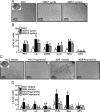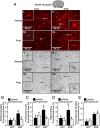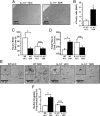β-Adrenergic receptor antagonism prevents anxiety-like behavior and microglial reactivity induced by repeated social defeat
- PMID: 21525267
- PMCID: PMC3160240
- DOI: 10.1523/JNEUROSCI.0450-11.2011
β-Adrenergic receptor antagonism prevents anxiety-like behavior and microglial reactivity induced by repeated social defeat
Abstract
Psychosocial stress is associated with altered immune function and development of psychological disorders including anxiety and depression. Here we show that repeated social defeat in mice increased c-Fos staining in brain regions associated with fear and threat appraisal and promoted anxiety-like behavior in a β-adrenergic receptor-dependent manner. Repeated social defeat also significantly increased the number of CD11b(+)/CD45(high)/Ly6C(high) macrophages that trafficked to the brain. In addition, several inflammatory markers were increased on the surface of microglia (CD14, CD86, and TLR4) and macrophages (CD14 and CD86) after social defeat. Repeated social defeat also increased the presence of deramified microglia in the medial amygdala, prefrontal cortex, and hippocampus. Moreover, mRNA analysis of microglia indicated that repeated social defeat increased levels of interleukin (IL)-1β and reduced levels of glucocorticoid responsive genes [glucocorticoid-induced leucine zipper (GILZ) and FK506 binding protein-51 (FKBP51)]. The stress-dependent changes in microglia and macrophages were prevented by propranolol, a β-adrenergic receptor antagonist. Microglia isolated from socially defeated mice and cultured ex vivo produced markedly higher levels of IL-6, tumor necrosis factor-α, and monocyte chemoattractant protein-1 after stimulation with lipopolysaccharide compared with microglia from control mice. Last, repeated social defeat increased c-Fos activation in IL-1 receptor type-1-deficient mice, but did not promote anxiety-like behavior or microglia activation in the absence of functional IL-1 receptor type-1. These findings indicate that repeated social defeat-induced anxiety-like behavior and enhanced reactivity of microglia was dependent on activation of β-adrenergic and IL-1 receptors.
Figures







References
-
- Anisman H, Merali Z, Poulter MO, Hayley S. Cytokines as a precipitant of depressive illness: animal and human studies. Curr Pharm Des. 2005;11:963–972. - PubMed
-
- Avitsur R, Stark JL, Sheridan JF. Social stress induces glucocorticoid resistance in subordinate animals. Horm Behav. 2001;39:247–257. - PubMed
-
- Avitsur R, Stark JL, Dhabhar FS, Padgett DA, Sheridan JF. Social disruption-induced glucocorticoid resistance: kinetics and site specificity. J Neuroimmunol. 2002;124:54–61. - PubMed
-
- Avitsur R, Padgett DA, Dhabhar FS, Stark JL, Kramer KA, Engler H, Sheridan JF. Expression of glucocorticoid resistance following social stress requires a second signal. J Leukoc Biol. 2003;74:507–513. - PubMed
Publication types
MeSH terms
Substances
Grants and funding
LinkOut - more resources
Full Text Sources
Medical
Research Materials
Miscellaneous
